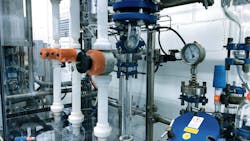Reliable pipes for aggressive chemicals — when ECTFE is safer than PFA
When transporting extremely aggressive media under pressures and elevated temperatures, safety, quality and reliability are paramount. Casey Williamson of GF Piping Systems explains how the use of products such as SYGEF ECTFE meets these critical services in this Q&A.
Q: The SYGEF ECTFE system is designed specifically for the transport of extremely aggressive media. Which industrial segments are you targeting with product development?
A: In principle, the high-end solution ECTFE is suitable for all industrial segments in which aggressive chemicals are transported under demanding temperature and pressure conditions. In addition to the chemical processing industry, these include water treatment, microelectronics and other applications.
Q: What chemicals are these, and what are the requirements for the transport of these media?
A: SYGEF ECTFE provides the user with an advantage wherever highly concentrated acids or alkalis are transported. Typical chemicals include concentrated sulfuric acid (H2SO4) or hydrogen peroxide (H2O2). Even under normal conditions, the transport of these media requires a highly reliable and durable piping system. With elevated temperatures, the piping systems must handle the intended pressures and the increased reactivity of the chemical to provide a reliable low-maintenance system for the system's intended life cycle. We have developed ECTFE precisely for this purpose.
Q: How have these chemicals been transported so far, and what are SYGEF ECTFE's advantages over other materials?
A: Until now, PFA has often been used for the transport of aggressive media. Like ECTFE, PFA is a fluoropolymer plastic with high chemical resistance. The main disadvantage of PFA is that the material has lower mechanical properties. This means that it is limited to small pipe sizes (under 63mm). In many applications, this solution becomes a space and cost issue for the end-user. Lined steel pipes are also used for the transport of aggressive media. Although lined steel has great mechanical properties, material costs are very high and require exact measurements for off-site fabrication. This can result in long lead-times.
Lined steel also has many potential leak points (due to multiple flanged connections) and is susceptible to external corrosion from permeation and environmental influences. ECTFE was not intended to replace existing thermoplastic piping systems but rather to complement them. Wherever conventional systems reach their limits or become uneconomical, the use of SYGEF ECTFE makes sense.
Q: What are your customers' special challenges concerning the field of microelectronics?
Microelectronics' special challenges often lie at the end of the production process when waste products have to be transported safely. For example, with the production of microchips, sulfuric acid is used for etching semiconductors or surface treatment. Hydrogen peroxide is also used to bind a base to an acid in the process. In the semiconductor industry, these acids occur in very high concentrations and at high temperatures. This is where conventional piping systems reach their limits. To compensate, the acids need to be cooled down and mixed with water to reduce the concentration. However, these measures are very expensive. The SYGEF ECTFE system approach of proper material selection with advanced design support, pipe stress modelling, comprehensive installation recommendations and industry-leading quality control recommendations provide a cost-effective alternative for such applications.
Q: To what extent does the assembly of ECTFE pipes differ from other systems?
Compared to lined steel pipes, the assembly of ECTFE lines is very simple, fast and cost-effective. To join ECTFE components, we use modern IR welding technology that fully controls and documents the fusion process. This process is characterized by very short fusion times and high reproducibility. Advanced quality control can be achieved by using the Weld Bead Inspection (WBI) tool to verify the weld was performed correctly. Lastly, the integrated process and quality control ensure the fusion process is documented, and the user can fully rely on the system.
About GF Piping Systems
GF Piping Systems is the leading flow solutions provider worldwide, enabling the safe and sustainable transport of fluids. The company specializes in plastic piping systems and system solutions plus services in all project phases. GF Piping Systems has its own sales companies in 31 countries, which means it is always by its customers' side. Production sites in 36 locations in America, Europe, and Asia ensure sufficient availability and quick, reliable delivery. In 2020, GF Piping Systems generated sales of CHF 1'708 billion and employed 6'893 people. GF Piping Systems is a division of Georg Fischer AG, which was founded in 1802, and is headquartered in Schaffhausen, Switzerland.
About the Author
Casey Williamson
Head of Business Development Global Industries Microelectronics at GF Piping Systems
Casey Williamson is Head of Business Development for Global Industries Microelectronics at GF Piping Systems.


